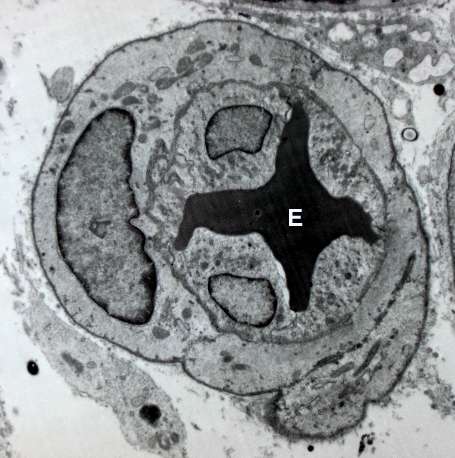Blood vessel with an erythrocyte (red blood cell, E) within its lumen, endothelial cells forming its tunica intima (inner layer), and pericytes forming its tunica adventitia (outer layer) Credit: Robert M. Hunt/Wikipedia/CC BY 3.0
Researchers have made a breakthrough in understanding blood vessel occlusion by discovering a novel pathway involved in this process.
The findings, which appear in the journal Blood, may lead to new treatments for clotting associated with atherosclerosis, cancer, heart attacks and strokes.
Clotting (thrombosis) is an important function of blood to prevent excessive bleeding, but it can become inappropriately activated during a stroke or heart attack. Earlier studies led by these same researchers identified that a protein called lysyl oxidase (LOX) is increased in certain blood cancers that have a high risk of clotting. However, the mechanism through which increased LOX leads to clotting was unknown until now.
In an experimental model that increased LOX activity in platelets (blood cells involved in clotting), researchers found that the time needed to form a blood clot after injury to the blood vessels was reduced. These platelets were more likely to form a clot and researchers pinpointed the specific receptor on the platelets affected by the oxidation activity of LOX. This receptor is responsible for platelet adhesion to proteins (collagen) in blood vessels.
"By using interdisciplinary approaches, we were able to extend discovery of basic mechanisms to in vivo studies" explains corresponding author Katya Ravid, DSc, PhD, professor of medicine and biochemistry at Boston University School of Medicine. Post-doctoral fellow, Dr. Shinobu Matsuuras is the study's first author.
This study has implications for various other diseases, such as vascular restenosis (blood vessel narrowing) and chronic kidney disease, in which there are high levels of LOX and increased blood clotting related complications.
Journal information: Blood
Provided by Boston University Medical Center























